Costa Rica, September 2013
Reanne Booker
Country of Service: Costa Rica
Dates of Assignment: September 7-14, 2013
Activities
How do you feel that your activities related to your understanding of what the Program Director wanted you to accomplish. What did you feel was your major contribution to the site?
Activities: My time in San Jose was divided between two hospitals, San Juan de Dios, where I spent three days and Hospital Mexico, where I spent two days. I had been in contact with one of the nurses from San Juan de Dios prior to departing for my trip and had asked for suggestions for potential topics to discuss/present to the staff.

My first day at Hospital San Juan de Dios was relatively informal. I spent much of the day with two nurses, one of whom spoke no English and the other, limited English. I was taken on a tour of the hospital and introduced to many people. My impression was that it was very important to the staff that they provide me with an overview of the resources available and the services offered to patients (inpatient wards, outpatient clinics, chemotherapy/daycare area). I was amazed to learn that Hospital San Juan de Dios is 179 years old!
On my second day at Hospital San Juan de Dios, I had the opportunity to attend rounds (breast cancer). The rounds were attended by physicians (radiation oncologists, medical oncologists, surgeons, radiologists and pathologists). My understanding was that nurses do not routinely attend such rounds. Of interest, following the presentation of the patient and brief discussion, all attendees made their way to a small exam room where the patient was waiting. The patient was examined and then the staff returned to the room where rounds were held and discussion ensued.
I was able to spend one-on-one time with one of the nurses on the inpatient women’s oncology ward. She acknowledged that there is no formal nursing education program at the hospital. As well, nurses do not receive much education during their orientation and certainly do not receive ongoing nursing education once they have been hired. She and I agreed to keep in contact; she will act as a liaison and will share any information with her colleagues that I send.
I was able to spend one-on-one time with one of the nurses on the inpatient women’s oncology ward [of Hospital San Juan de Dios]. She acknowledged that there is no formal nursing education program at the hospital. As well, nurses do not receive much education during their orientation and certainly do not receive ongoing nursing education once they have been hired. She and I agreed to keep in contact; she will act as a liaison and will share any information with her colleagues that I send.
 The nurse manager on the women’s inpatient oncology ward (left) and one of the nurses preparing medications for the patients on the women’s inpatient oncology ward (right), San Juan de Dios.
The nurse manager on the women’s inpatient oncology ward (left) and one of the nurses preparing medications for the patients on the women’s inpatient oncology ward (right), San Juan de Dios.
I also spent some one-on-one time with a psychologist who works with a private organization, Proyecto Daniel (‘Project Daniel’), an initiative that is funded privately by the family of a young teen who passed away from cancer. In Costa Rica, children older than 12 are treated in the adult facilities. Proyecto Daniel aims to improve the experience of cancer treatment for teens and young adults, as well as provides support to the families. There are several rooms in Hospital San Juan de Dios and Hospital Mexico that are apportioned to teens/young adults. The psychologist that I met with was very interested in connecting with a Child Life Specialist from Canada. There are currently no Child Life Specialists or Child Life Programs in Costa Rica. Since returning home, I have connected this psychologist with a Child Life Specialist from the Alberta Children’s Hospital in Calgary, Alberta.
I spent the afternoon providing one-on-one information to one of the chemotherapy nurses. We discussed chemotherapy induced nausea and vomiting and peripheral neuropathy (discussion was supplemented by powerpoint presentations). We also discussed chemotherapy administration (including safe handling recommendations). The nurse indicated that she was interested in establishing a nursing education network or group at San Juan de Dios. We talked about ways to initiate nursing education initiatives, such as journal clubs and setting up a ‘wall of learning’ in their lunch room.
 The outpatient chemotherapy room at San Juan de Dios (left); the room (middle) where I did an impromptu educational session with one of the chemotherapy nurses (right).
The outpatient chemotherapy room at San Juan de Dios (left); the room (middle) where I did an impromptu educational session with one of the chemotherapy nurses (right).
On my third day at San Juan de Dios, I gave a formal lecture (‘Oncologic Emergencies’). The presentation was well attended; the audience was predominantly comprised of nurses but there were also several physicians in attendance. I was fortunate that one of the nurses was able to translate the lecture for me. I had purchased translation software and had translated the content so that the slides being presented were in Spanish; however, I am quite certain that the translation was not 100% perfect (as evidenced by some giggles that emerged as one slide was presented). I’d asked the nurse who was translating to clarify what was going on and he indicated that the attempt to translate the content into Spanish resulted in something quite funny (hopefully, it was not offensive!) I received positive feedback following the presentation. One of the physicians who attended indicated that the presentation was very relevant and helpful.
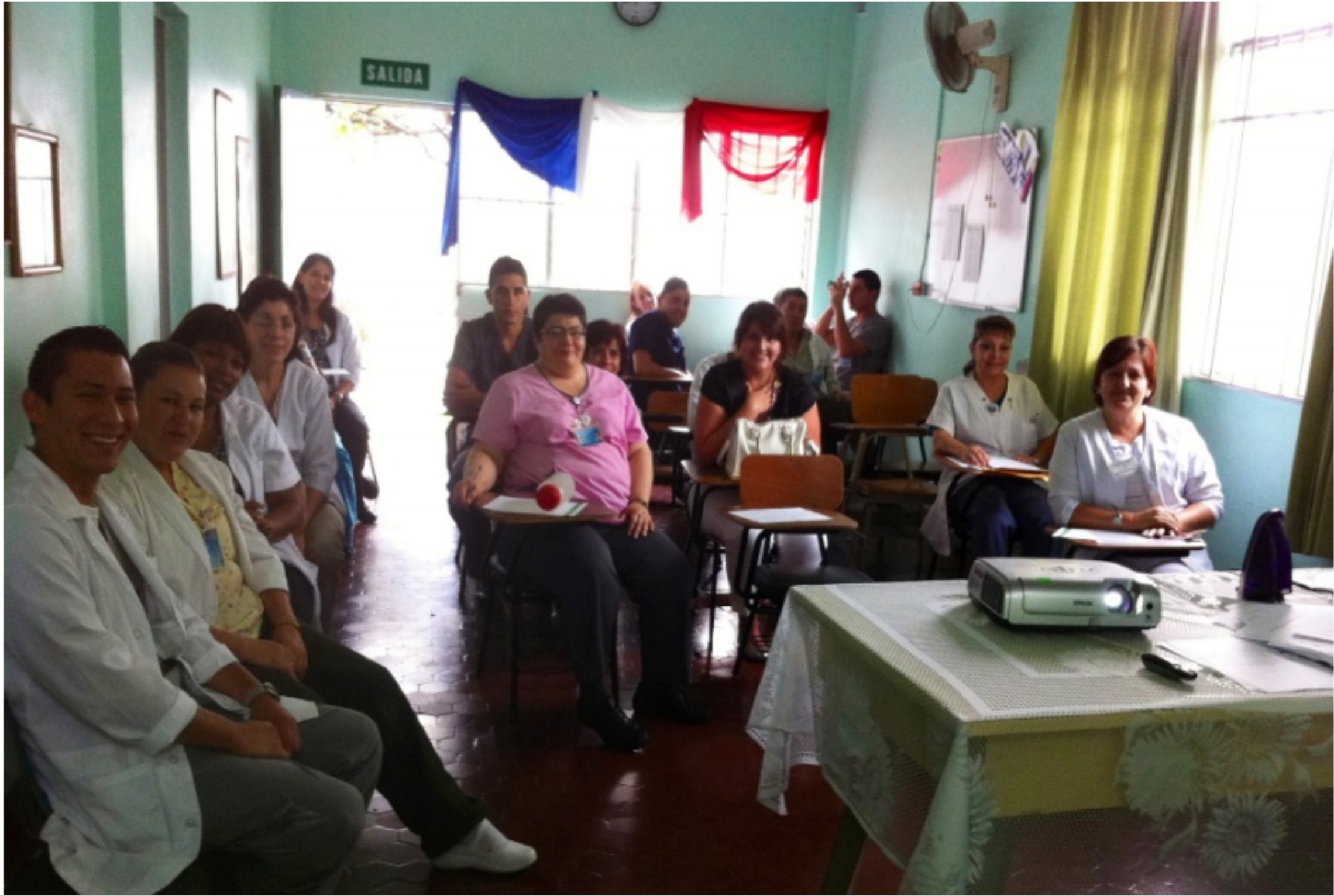 Nurses and physicians who attended my lecture at San Juan de Dios.
Nurses and physicians who attended my lecture at San Juan de Dios.
I began each of my two days at Hospital Mexico giving formal lectures from 0700-0830. The lecture on my first day at Hospital Mexico was on oncologic emergencies. The lecture was well attended, with the audience primarily comprised of nurses as well as a few medical oncologists. I was then taken on a tour of the new cancer center. At this time, only the radiation oncology department is open. Hospital Mexico has the only linear accelerators in the country. Hospital San Juan de Dios does offer some radiation oncology services but uses cobalt; the radiation services offered are exclusively palliative. The chemotherapy unit at Hospital Mexico is scheduled to open soon. The unit was set up with individual recliner chairs with each chair separated by half-walls. The unit is very modern and bright with lots of windows and natural lighting as well as numerous televisions for the patients.
I was also provided with a tour of the outpatient areas and chemotherapy unit where patients are currently being treated. I spent some one-on-one time with one of the nurses who identified that she would like to establish an ongoing nursing education program at Hospital Mexico. She and I have exchanged emails since my return to Calgary and I have sent her powerpoint slides and additional information and resources
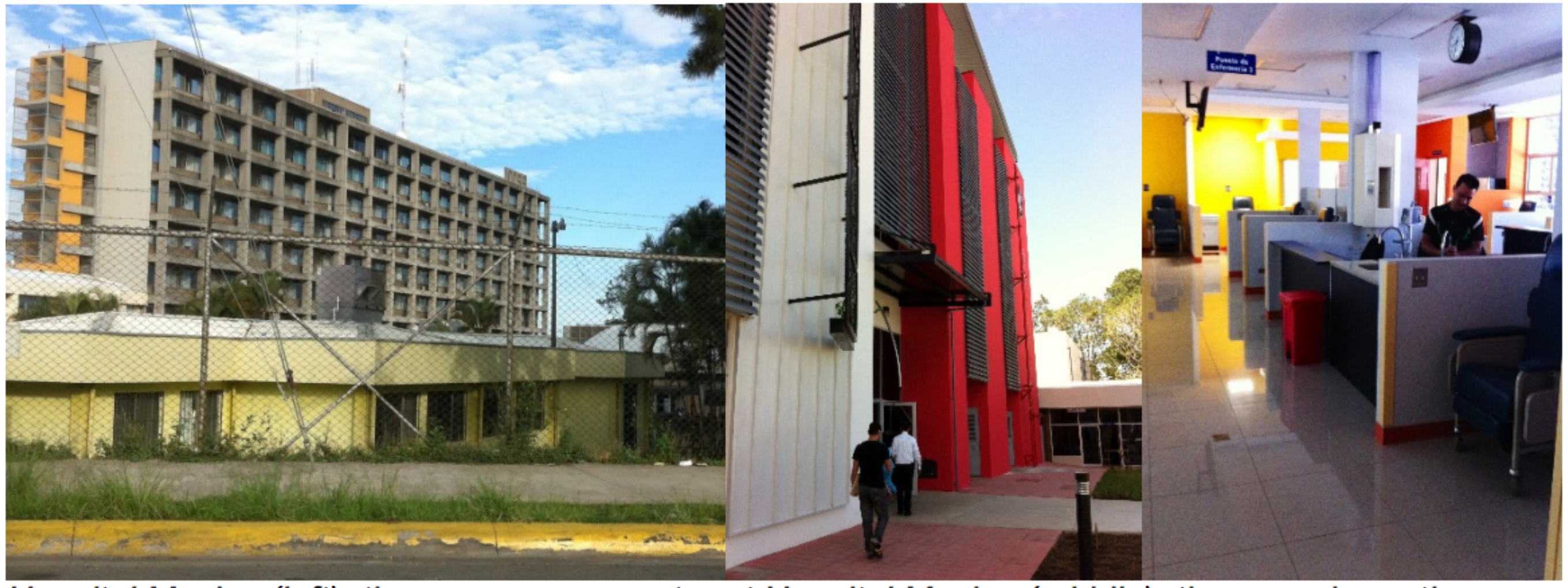 Hospital Mexico (left); the new cancer center at Hospital Mexico (middle); the new chemotherapy unit at Hospital Mexico (right)
Hospital Mexico (left); the new cancer center at Hospital Mexico (middle); the new chemotherapy unit at Hospital Mexico (right)
The lecture that I presented on my second day at Hospital Mexico was on cancer and sexuality. I had been surprised when asked to present this topic as I’d wondered if culture/religion would perhaps be a barrier to this topic. Based upon the nature of the questions asked during and following my presentation, I quickly realized that the staff were contending with similar issues with their patients as I was back home.
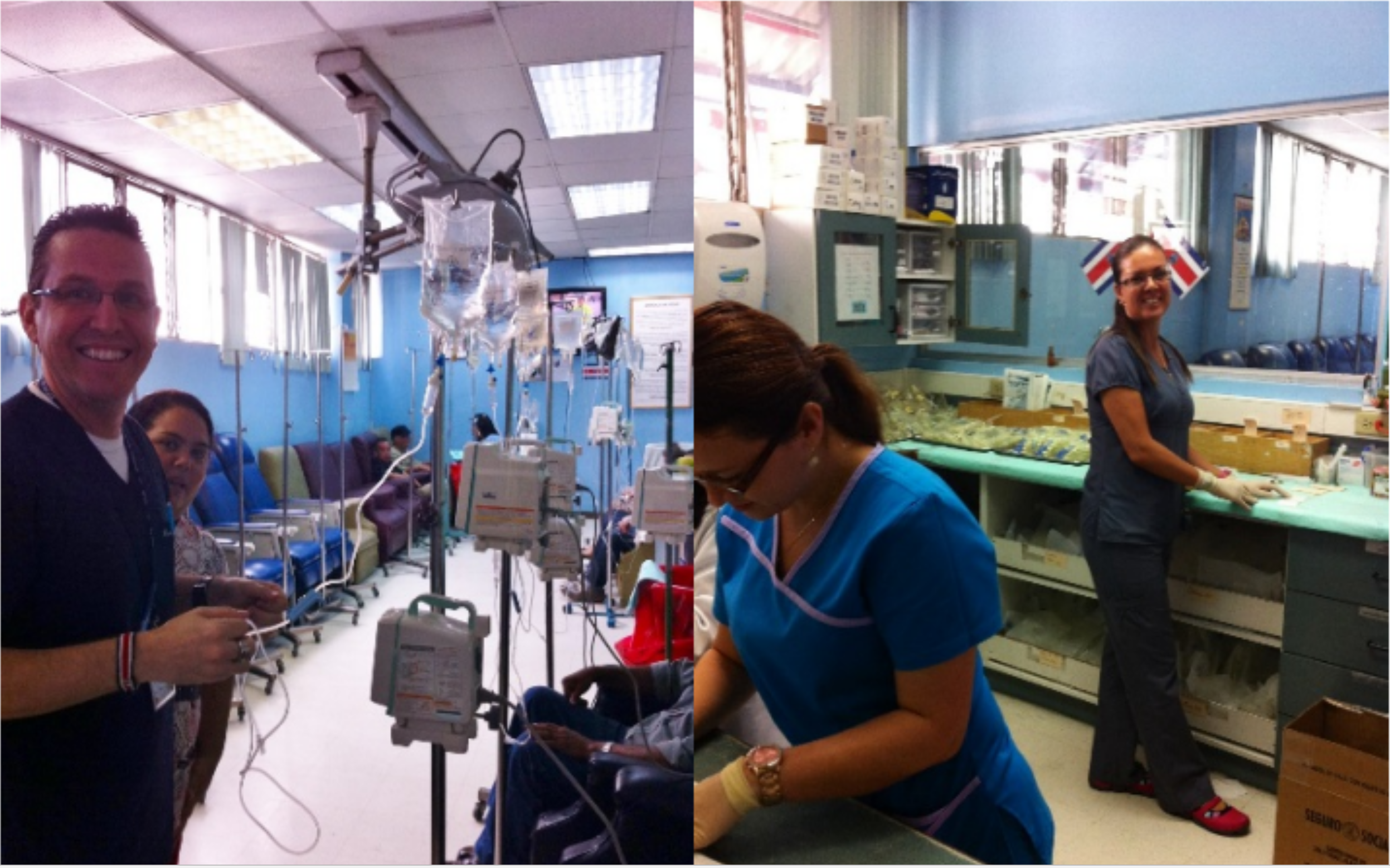 The current chemotherapy unit at Hospital Mexico (left); the medication preparation room adjacent to the chemotherapy unit (right)
The current chemotherapy unit at Hospital Mexico (left); the medication preparation room adjacent to the chemotherapy unit (right)
Culture and religion did not appear to be as significant a barrier as I’d anticipated and I found myself feeling a bit sheepish at having assumed so in the first place.
Lectures given:
San Juan de Dios
September 11, 2013
- Oncologic Emergencies: Hypercalcemia of malignancy
- Superior vena cava obstruction
- Tumor lysis syndrome
- Febrile neutropenia
Hospital Mexico
September 12, 2013
Oncologic Emergencies:
- Hypercalcemia of malignancy
- Superior vena cava obstruction
- Tumor lysis syndrome
- Febrile neutropenia
September 13, 2013
- Sexuality and Cancer
- Strengths/weakness of trainees
 Nurses and physicians who attended my lecture on oncologic emergencies (left); nurses and physicians who attended my lecture on sexuality and cancer (right)
Nurses and physicians who attended my lecture on oncologic emergencies (left); nurses and physicians who attended my lecture on sexuality and cancer (right)
I believe that one of the biggest strengths of the staff is their willingness to learn. Staff were very open and interested in hearing about various topics and seemed very grateful to have an HVO volunteer come to their hospital. The nurses that I met were very keen on obtaining more information about oncology nursing. Several nurses were interested in establishing more formal nursing education initiatives at their hospitals. The nurses are all highly educated with several having obtained graduate degrees. In spite of having advanced education and training, it seems that scope of nursing practice is still evolving. There are no ‘nurse practitioner’ or ‘clinical nurse specialist’ roles in Costa Rica although there does seem to be interest from nursing and medical staff in establishing more formal advanced practice roles.
I do not feel that there were any specific weaknesses but did find it challenging to overcome the language barrier and strongly recommend that an interpreter be available to translate if HVO volunteers do not speak Spanish.
Of note, I found that there was little interaction between staff on various units (chemotherapy, outpatient clinics, inpatient wards) and really no interaction between staff at the two hospitals (Hospital Mexico and San Juan de Dios). Several nurses were interested in making connections and establishing networks, particularly as related to nursing education endeavors.
In terms of infrastructure, I found it interesting that there was no internet access in either hospital although Wifi is widely available in Costa Rica and all of the nurses that I met had smart phones.
 One of the nurses from San Juan de Dios who took me out for coffee.
One of the nurses from San Juan de Dios who took me out for coffee.
Overall, I feel that my biggest contribution was that I was able to build relationships with several nurses and psychologists who identified that the pursuit of ongoing education (oncology nursing, psychosocial oncology) was important to them. While I do feel that my presentations were very well received and appreciated, I feel that it is the connections that I made as well as my commitment to ongoing collaboration that will have the most significant impact.
Prior to my departure for Costa Rica, I purchased two tablets (ASUS Memo Pad HD7). I loaded each tablet with several of my presentations (the versions that I’d had translated into Spanish). I also loaded several additional resources in Spanish (NCCN guidelines, the ESAS, a brochure on fertility published by Fertile Hope). Further, I bookmarked several oncology websites that were available in Spanish (ASCO’s Cancer.Net, American Cancer Society, National Cancer Institute, NCCN). When setting up the tablets, I ensured that both tablets were set with Spanish as the language. I gave one tablet to my primary contact nurse at each hospital; they were extremely appreciative of the tablets.
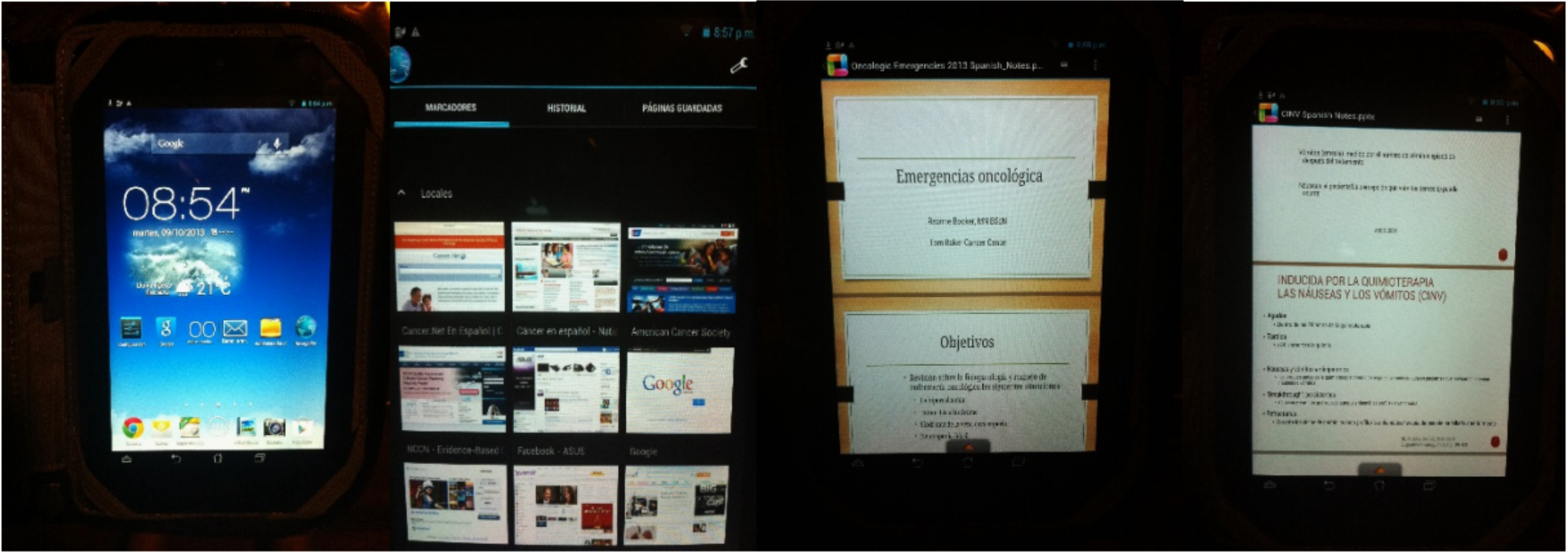 The ASUS tablets that I purchased for each hospital.
The ASUS tablets that I purchased for each hospital.
I had also contacted the Oncology Nursing Society prior to going to Costa Rica and was fortunate to be able to bring over a number of textbooks on general oncology, oncology nursing and chemotherapy administration. I gave these textbooks to the staff at San Juan de Dios. In spite of the textbooks being written in English, the staff were very thankful when I gave them the books.
 The manager of the outpatient chemotherapy unit, San Juan de Dios (left) and one of the chemotherapy nurses (right) with a few of the books donated by ONS.
The manager of the outpatient chemotherapy unit, San Juan de Dios (left) and one of the chemotherapy nurses (right) with a few of the books donated by ONS.
Assessment
Did your activities meet the needs of
- the local people;
- the host institution;
- your counterpart; and
- the trainees?
If not, why?
Yes, I believe my activities met the needs of the staff and host institution. I received positive feedback from the staff while I was there as well as have received several emails since returning home from staff who expressed their appreciation to me.
Were you able to devote as much time to training-related activities as you thought appropriate? If not, why?
Yes. I do think it would have been helpful to have been there for a longer period of time as it took some time to get oriented to each hospital.
Was there one person (patient, colleague, family member of a patient) who really touched you during your trip? Why?
I was extremely honored to meet the incredible nurses and staff at each hospital. I was very moved by the warm and gracious nature of the staff. There was one ‘champion’ nurse at each hospital who seemed very interested in advancing their nursing education programs. I was very humbled by the amazing job that everyone was doing, despite having access to far fewer resources than I am accustomed to. I will never forget the kind, genuine and generous people that I met during my trip.
Cross Cultural Interaction
Were there significant cultural differences between yourself and your counterpart(s) that significantly decreased your effectiveness as a volunteer?
Not that I experienced (aside from the language barrier).
Are there specific cultural issues that you feel future volunteers should be aware of (e.g. male/female dynamics, divergent attitudes towards work, different perceptions of professional roles, etc.)?
No; not that I am aware of.
 Hospital San Juan de Dios
Hospital San Juan de Dios
Orientation
Was your pre-departure briefing(s) from the Program Director adequate and appropriate?
Yes, I felt that I received excellent advice and support from the Program Director.
Did you have a good idea of what you were expected to accomplish during your visit?
I did feel as if the expectations were somewhat ambiguous but realize that I was the first volunteer to go to this site. While I might have felt more comfortable if I’d had a set schedule or agenda in mind, I recognize that it was very important to first get a sense of what the needs of the staff were and to tailor my activities accordingly.
I found it a bit challenging in that I wanted to maximize the time that I had at each hospital. I went to Costa Rica with a fairly firm notion of what I should do to make the best use of my time. I had anticipated giving numerous formal presentations and adhering to a strict timetable (perhaps a reflection of the quite unyielding nature of schedules and agendas that seem to be customary in the Canadian healthcare system). What I quickly realized was that it was better to just be open to the experience and adapt to the needs of the staff as they arose. It meant that I had to be comfortable with spontaneity and know that I would leave with less tangible evidence of what I had accomplished than if I would have done numerous presentations. In retrospect, I think it was somewhat inevitable to feel this way given that I was one of the first volunteers to visit the hospitals and it was not possible to know with certainty what to expect.
Were the orientation materials in Orientation Packet and on the HVO KnowNET helpful?
Yes, I visited the HVO KnowNET site several times prior to my trip. I found the information very interesting, relevant and helpful.
Living Conditions
Please provide a brief comment on the living conditions including:
-
Housing
I stayed at a hotel that was approximately 20 minutes from the hospitals. I had looked into numerous hotels prior to going to Costa Rica; there are many options available to meet various budgetary needs. I did not have the opportunity to see any of the hotels that were close to the hospitals, aside from a brief glance while driving by. -
Local transportation
The only mode of transportation that I utilized while in San Jose was taxi. I found the taxi services to be efficient and inexpensive. The bus system seemed quite sophisticated although I did not have the opportunity to try it out. -
Entertainment
I did not have the opportunity to take in any formal entertainment activities. However, I did see that the local football stadium was quite close to Hospital San Juan de Dios. In addition, there are lots of wonderful restaurants and coffee shops near the Hospitals. There are also several shopping centers within a short taxi ride from the Hospitals. -
Activities for spouses and families
There are numerous activities for spouses and families to partake in within San Jose as well as a number of day tours that leave from San Jose to various tourist destinations (beaches, nature reserves, Poas volcano, coffee plantations).
Note any changes that need to be made to the Program Description regarding the living situation.
G. Suggestions
Do you have suggestions for changes and/or improvements in:
-
Types of activities the volunteer is expected to engage in
-
The linkage and communication between HVO/Washington, the Program Director, the host institution, and the volunteer
-
The pre-departure orientation
I do not have any suggestions for changes or improvements; I felt very supported by HVO and in particular, by Dr. Barb Wise and Dr. Luis Corrales.
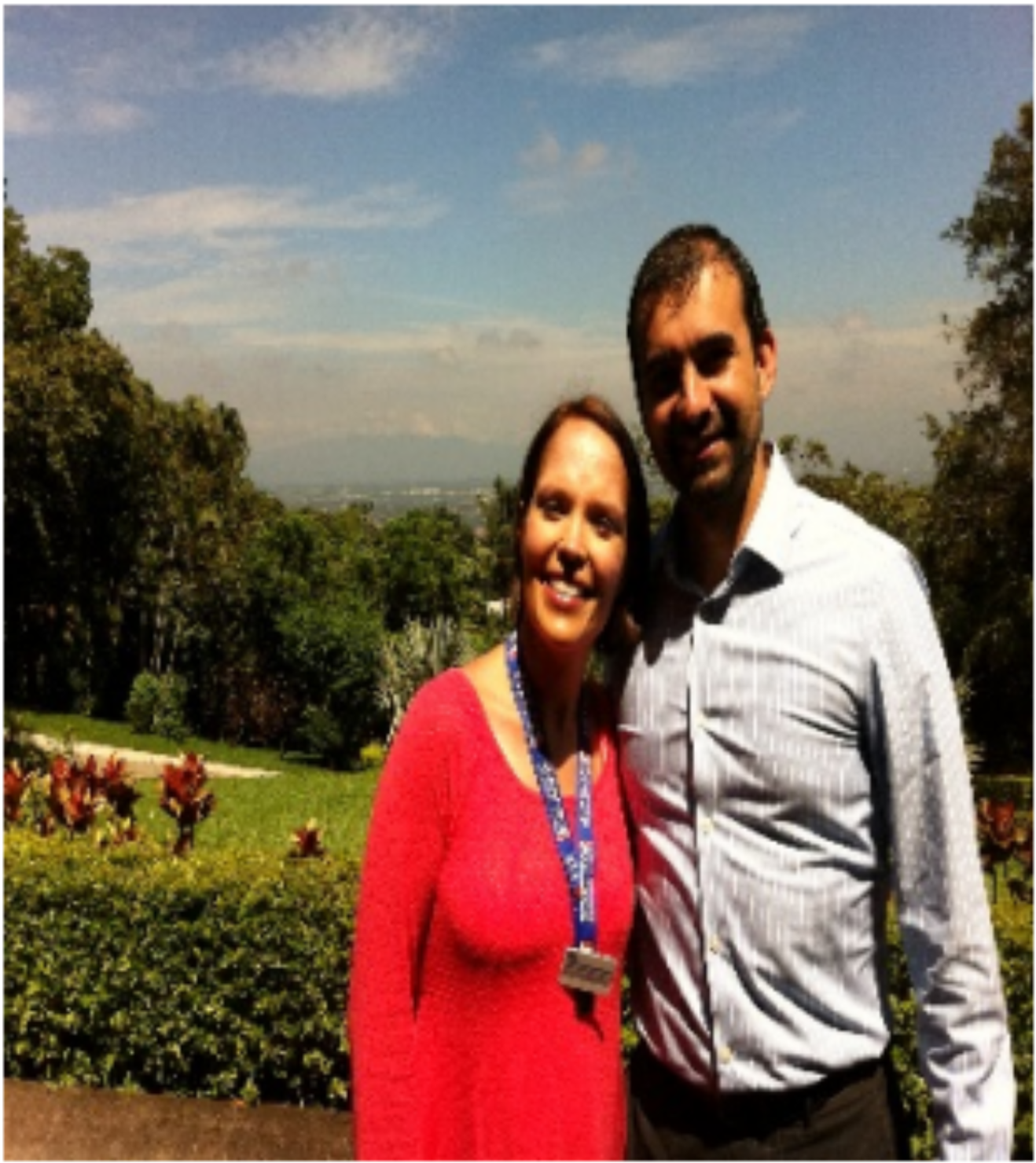 With Dr. Luis Corrales
With Dr. Luis Corrales
Summary
All in all, was this a worthwhile experience?
I am incredibly grateful to ASCO and HVO for the opportunity to go to Costa Rica. The experience was incredible and absolutely worthwhile.
Would you go again? What was the most memorable moment of your trip?
I would love the opportunity to return to Costa Rica. It is difficult to pick one memorable moment as there are numerous that come to mind. The people that I met were exceptionally kind and generous. It was amazing to know that in spite of the thousands of miles that separate our countries, we share similar goals and ideals when it comes to oncology nursing and trying to provide the best possible care for our patients.
I went to Costa Rica expecting to teach and share knowledge; I had not expected to learn so much myself. It was extremely enlightening to see the exceptional job that the nurses and staff do with far fewer resources than are available in Canada. I also appreciated the opportunity to embrace the ‘pura vida’ philosophy. My first world, type A ego is so accustomed to rigid schedules and structure that it was refreshing to be able to slow down and go with the flow.
Without a doubt, the most memorable aspect of my trip was that I was incredibly blessed to meet so many amazing people. I have no doubt that professional alliances were forged but somewhat unexpectedly, I was fortunate enough to also gain a number of new friends.
 My two primary contact nurses. Marianela (left) from San Juan de Dios and Leticia (right) from Hospital Mexico.
My two primary contact nurses. Marianela (left) from San Juan de Dios and Leticia (right) from Hospital Mexico.
Additional Materials Needed
If you developed any educational materials for this assignment (handouts, PowerPoint presentations, resource lists, etc) please send them to HVO for posting on the KnowNET.
I will send copies of the powerpoint presentations to HVO.
These are the websites that I bookmarked on the tablets:
http://www.cancer.net/cancernet-en-espa%C3%B1ol
http://www.cancer.org/espanol/index
We encourage you to send us digital photos of your experience. We are always looking for photos of volunteers in action and other scenes that we can use on the web site and in our printed materials. Depending on the size of these items, it may be easiest to put them on a CD-Rom along with your trip report and mail them to HVO at the address below. We prefer that you submit your Trip Report via e-mail to info@hvousa.org. You may also submit your Trip Report via mail or fax.
Health Volunteers Overseas
1900 L Street, NW #310
Washington, DC 20036
Tel: (202) 296-0928
Fax: (202) 296-8018
E-mail: info@hvousa.org

